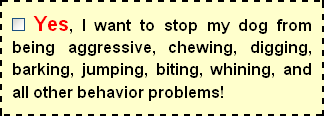Training A Dog Not To Bite
Training A Dog Not To Bite - Training your dog is important if you want him to know his place in the family. You may love to spoil and pamper him but he still needs to understand that you are the pack leader and he is not. This article can help you to understand the benefits of training your dog.
You, as the leader of the pack, should always eat first. In the animal world the Alpha always eats before the rest of the pack. This confirms dominance and establishes trust in the leader. When you exhibit this behavior you teach your dog to respect you as leader and also to trust that you are leading in the proper way.
Treats are not the mainstay for rewarding your pet when training. Dogs will learn that if you give them a treat for a response they should expect it always. This is not necessary and should be reserved for occasional rewards. Dogs see loving, physical contact as a reward as well and will enjoy it much more than a treat that is gone in a split second.
Although a well trained dog can be taught to put up with just about anything, there will be times and situations where they are truly uncomfortable with a person, another animal, or a place. Don't force your dog to suffer through more of this discomfort than is absolutely necessary. There is a reason that they are uncomfortable and you need to determine that reason.
It takes many repetitions before a dog is able to learn new commands. You may need to repeat the same command lesson from 25 to 30 times before your dog learns it. Continue repeating the same command with patience, and eventually your dog will learn it.
To teach your dog to sit, gently push down on his behind as you give the verbal command "Sit!" and make a hand gesture with your palm facing down. Each time your dog sits successfully, even if you have to help him out, give him a treat and praise him. It is important that your dog know how to sit so that you can build on this command and eventually teach him to "Stay!"
Take a class on training or study books and websites regarding the topic before starting to train your dog. It seems easy to train a dog but a lot of things that make sense to us won't make sense to a dog. Learning the proper way to train and studying how to run a good training session will be beneficial for you both during this process.
Be consistent when training your dog. Your furry buddy will be easily confused when you vary your routine too much. Always give the same encouragement for a job well done. Use the same phrases to help your dog recognize what words are for what actions. Always say 'good dog' and don't vary the tone.
When training your dog, be competent! Your dog wants to know that you are in charge and that you know what you are doing. If you are inconsistent, anxious, irritable, angry, or in any way unstable while training your dog, you will not succeed. You must be calm, consistent, and competent. If you don't know about dog training, it is a very good idea to learn from books, videos and people who know before you ever get a dog!
If you want your dog to stop digging, play with him in the yard. Many dogs who dig do so out of boredom and the desire to get back at their owner. Playing in the yard with your pet offers him the socialization and exercise he needs, and it is also a fun way to bond with your favorite pooch.
Remember how many treats you reward your dog with during the course of the day to avoid fattening him up. It's very easy to overlook how many treats you give your dog, especially during a training session, but they add up if you don't pay attention.
Train your dog so that living together is fun for both you and your dog. Living with a dog should not be a hardship, but it can be if you don't take the time to research the type of training a dog understands. A dog does not think like a human, so learning how to train in a way they understand will make it easier for both of you.
A good dog training tip is to not spoil your dog by giving them dinner scraps all the time. The more you spoil your dog, the more you enable bad behavior such as begging. Instead, make treats part of a reward system. When your dog has been good, give them a treat as a reward.
As already stated, dog training can be important for getting your dog off to the right start in the family. It will be harder if you wait till later to try training. This article can help you to make the decisions about dog training that can help your dog keep his place as a cherished family member.
Training A Dog Not To Bite




